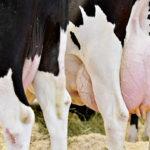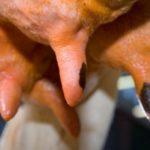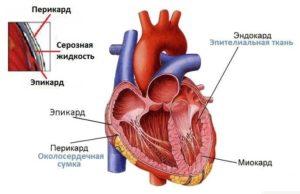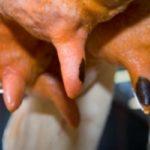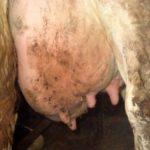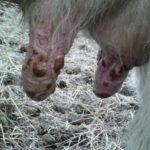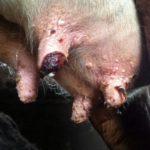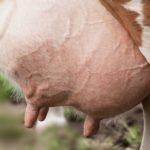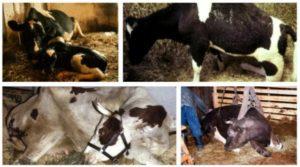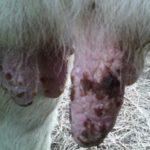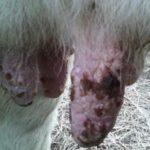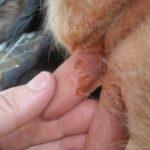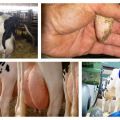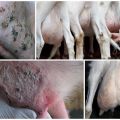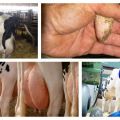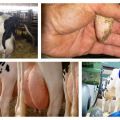16 common cow udder diseases and their treatment
Diseases of the udder occur in cows due to microtraumas and non-observance of hygiene rules during milking. The main reason is infection with an infection that penetrates the damaged tissue. Diseases are recognized by external changes in the udder. The milk supply also decreases, it is difficult to express, and milking becomes painful for the cow. It is important to start treatment at the first symptoms to maintain milk yield and animal health.
Content
- 1 The importance of the mammary glands
- 2 Common diseases
- 2.1 Mastitis (inflammation)
- 2.2 Milk stones in the udder
- 2.3 Cracked nipple skin
- 2.4 Injury
- 2.5 Udder induration
- 2.6 Foot and mouth disease
- 2.7 Abscess
- 2.8 Warts (papillomas on the udder)
- 2.9 Dermatitis
- 2.10 Furunculosis
- 2.11 Swelling after calving
- 2.12 Smallpox
- 2.13 Milk incontinence
- 2.14 Milk retention
- 2.15 Narrowing of the nipple canal (tightness)
- 2.16 Congenital absence of the nipple canal
- 3 Prevention of udder diseases
The importance of the mammary glands
The udder consists of three tissues, each of which has an important function:
| Udder tissue | Function |
| Glandular | Produces milk |
| Connecting | Protects glandular tissue from mechanical damage |
| Fatty | Provides thermoregulation and protection |
The glandular tissue consists of cavities - alveoli. From them, milk enters the wide ducts - tanks, and then is discharged through the channels and openings in the nipples.
Common diseases
Cows most often experience skin damage, inflammation of internal tissues, and problems with expressing milk. Congenital pathologies are less common.
Mastitis (inflammation)
The breasts become inflamed as a result of a bacterial infection. Mastitis develops in cows after cuts, bruises, hypothermia and overheating in the sun. The disease affects one or more quarters of the udder.

Symptoms:
- temperature increase;
- edema;
- redness;
- purulent and bloody discharge from the nipples.
Mastitis is treated with antibiotics and topical antiseptic ointments.
Milk stones in the udder
Substance disturbance, incomplete emptying of the udder, inflammation of the canal walls lead to clogging of the teats with deposits of phosphorus salts and hardened casein flakes.
Cracked nipple skin
The skin is cracked due to improper milking of cows, accumulation of dried milk residues.
Signs:
- cracks along the nipples with hard edges;
- milk is tightly expressed;
- milking hurts.
Treatment:
- wash the udder with laundry soap, rinse with warm water;
- treat cracks with a weak solution of manganese, hydrogen peroxide or 2% soda solution;
- lubricate wounds with iodine;
- in case of suppuration, apply an antibacterial ointment.
Purulent cracks without treatment will lead to the development of mastitis, phlegmon.
Injury
Causes of udder bruises:
- accidental hit while grazing in a forest belt;
- skirmishes between cows.
From the blow, blood vessels in the internal tissues of the udder are torn, swelling, blue discoloration and a lump occur. With severe damage, blood passes into the milk. It is poorly expressed from a bruised nipple due to a hematoma.
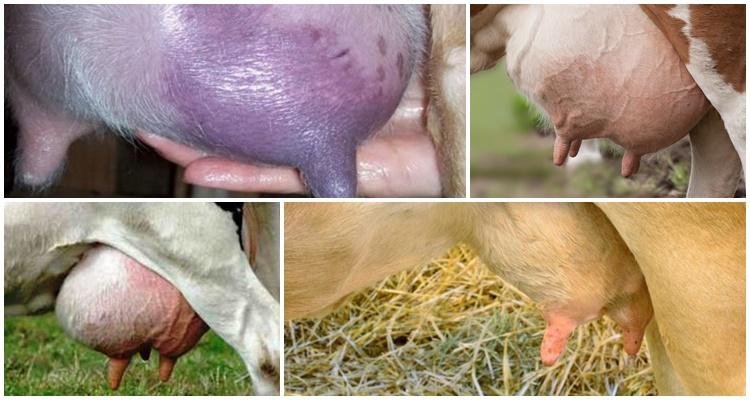
How to treat a bump in a cow:
- treat with iodine;
- apply ice or clay mixed with vinegar for two days;
- on the third day, lubricate with heparin ointment and massage gently;
- to clear the nipple from clotted blood, inject a solution of soda through the catheter, massage and express in half an hour.
For painful bruises, a novocaine blockade is placed, the udder is surgically cleaned from hematomas and antibiotics are administered.
Udder induration
Pathology occurs due to prolonged edema or after inflammation. The glands gradually thicken, only flakes can be seen in the milk. Induction develops painlessly and cannot be treated.
Foot and mouth disease
A viral disease is transmitted through the saliva of sick animals, clothing, food.
Signs:
- on the skin of the udder, on the mucous membrane of the mouth and nose, round yellowish-gray ulcers form - aphthae;
- the temperature rises to forty degrees and above;
- milk yield decreases, milk tastes bitter.
The nipples become clogged with fibrous and casein plugs, causing mastitis. There is no cure for foot and mouth disease, so sick cows only get better symptoms.
Abscess
Inflammation in tissues develops as a result of infection from scratches and cracks. An abscess is accompanied by a high fever and swollen lymph nodes. A cavity with pus forms in the wound. The abscesses are opened, cleaned with hydrogen peroxide, smeared with iodine and ichthyol ointment. Antibiotics are prescribed for the infection. In case of abscesses, massage cannot be done, otherwise the inflammation in the blood vessels will cover the entire udder.
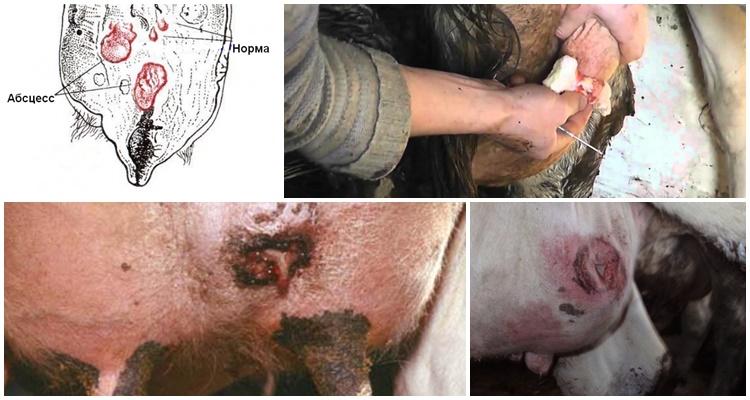
Warts (papillomas on the udder)
Benign lesions appear on the skin and mucous membranes. Papillomatosis is dangerous because it is transmitted to humans.
Treatment:
- single warts are tightly tied at the base with cow hair from the tail, the growths dry up and fall off;
- if a large area of skin is affected, the cow is given magnesium with food for ten days - 30 grams per day, external agents are used.
Cows' warts are lubricated with liquid nitrogen, lapis pencil, salicylic collodion, Antiborodavka ointment.
Dermatitis
Symptoms:
- nipples and udders turn red;
- deep ulcers appear;
- a seal is formed between the lobes of the udder, which cracks and festers;
- the skin becomes covered with small and large abscesses.
How to cure milking in cows:
- wash the udder with laundry soap or soda solution;
- clean and dry skin is smeared with ichthyol and glycerin, mixed in the same amount, or zinc ointment, burned with lapis or compresses from a solution of nitric acid silver are applied;
- weeping dermatitis is sprinkled with a mixture of equal parts of xeroform, zinc oxide, tannin and talc;
- with suppuration, washing with hydrogen peroxide and the use of antibacterial ointments helps.
To relieve pain, novocaine powder is added to the ointment.
Furunculosis
The disease is caused by staphylococci or streptococci. Furunculosis often occurs during lactation. The infection spreads in unsanitary conditions.
Symptoms:
- the appearance of cone-shaped swelling on the udder;
- red inflammations give way to white suppuration caps.
Treatment:
- wipe fresh boils with camphor, salicylic alcohol or iodine;
- smear with ichthyol ointment.
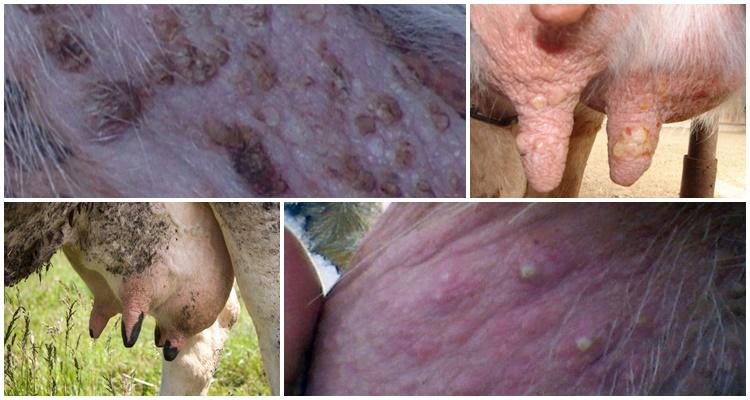
With bursting boils, antibiotics are prescribed and a novocaine blockade is put. Vitamins are added to the diet of cows. Also, the udder is heated under an ultraviolet lamp.
Swelling after calving
A swollen udder after birth is normal in first-calf heifers. The swelling disappears after a few days.
If the edema does not subside for a long time, and the udder hurts the cow, they begin treatment:
- give less succulent food and water;
- milked 8 times a day;
- massage the udder from the nipples to the base;
- calcium preparations are injected;
- apply an ointment against inflammation and edema.
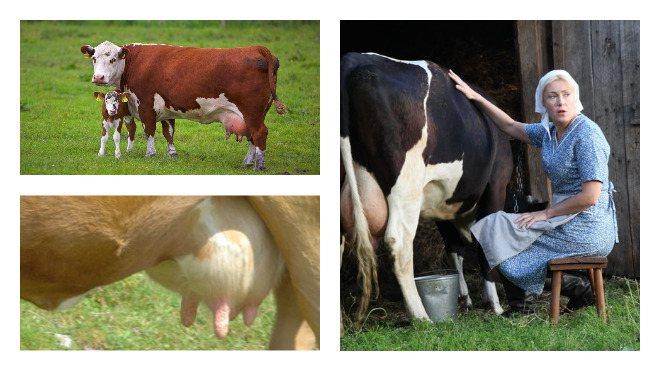
In addition to the main treatment, washings with a decoction of juniper or birch buds are used.
Smallpox
Sores appear on the udders of young cows. Smallpox manifests itself with clear symptoms:
- a yellow spot with a red rim forms on the skin;
- the speck is inflated into a bottle of liquid;
- pus forms inside;
- the bubble bursts, and a sore remains;
- the wounds are crusty and scarred.
From the appearance of spots to the formation of scars, it takes from three weeks to three months. Smallpox is treated with external drugs: synthomycin, zinc, streptocidal or xeroform ointment. During treatment, the udder is carefully monitored.
Milk incontinence
The reasons:
- paralysis of the muscles of the udder;
- scar in the nipple;
- stress;
- cold, heat.
Milk flows spontaneously when the cow is standing still and during washing before milking.
Treatment for stress incontinence:
- nipples are massaged after milking;
- dipped in collodion, which dries up and forms a protective film.
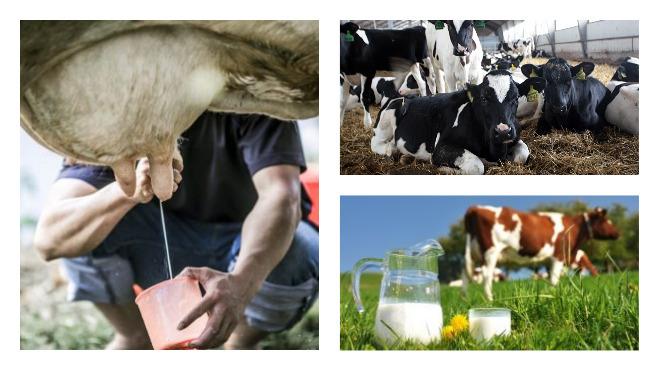
To stimulate the paralyzed sphincters, you need to take the following measures:
- the skin around the nipple is stitched with a medical thread moistened with a 5% iodine solution;
- a milk catheter is inserted into the canal;
- pull together the thread;
- after 10 days, the threads are removed.
The work of the healed nipple is restored with the help of plastic surgery.
Milk retention
Muscle contraction, vasoconstriction as a result of stress leads to partial or complete blockage of the excretory channels in the nipples.
Detention treatment:
- massage the udder before milking;
- take a break for massage during milking;
- eliminate irritating factors;
- for prolonged detention without primary diseases, bromide salts are used.
Lactation disorders are characterized by a sharp reduction in milk yield and frequency.
Narrowing of the nipple canal (tightness)
Milk is poorly milked due to congenital abnormalities, trauma or illness, as a result of which the nipple is overgrown with scar tissue. The normal diameter of the outflow channel is 2.5-4 millimeters. With tightness, it narrows to two millimeters or less. The nipple hardens, and a scar covers the top. To squeeze out a thin stream, you have to make an effort. Such milking harms the cow: under pressure, the mucous membrane breaks, inflammation occurs.
The patency is restored only by surgery.
Congenital absence of the nipple canal
Pathology is detected at the first lactation. There is no outlet channel or opening in the nipple at all. When the milk is squeezed out, a thin skin is inflated at the end. A quarter of the udder will gradually atrophy if not emptied. You can punch the hole yourself: pierce the skin stretched under the pressure of milk with a sterile needle, cauterize with a red-hot knitting needle or cut with scissors.
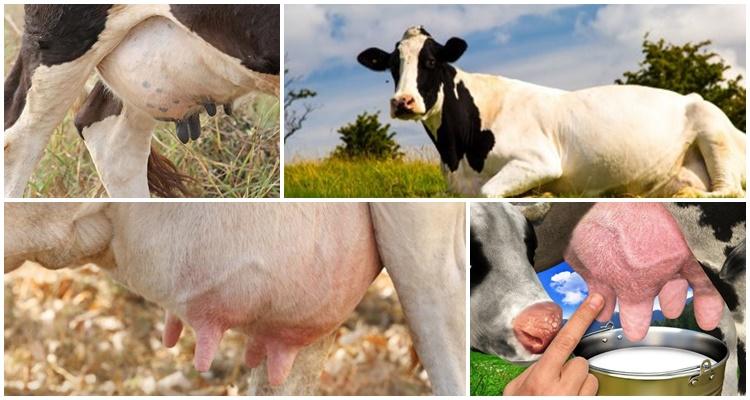
To prevent the hole from overgrowing, the cow is often milked, a catheter is inserted into the nipple, and smeared with petroleum jelly between milkings. The canal is pierced under sterile conditions with a surgical instrument - a trocar.
Prevention of udder diseases
How to prevent the spread and reoccurrence of diseases:
- milking with three fingers, before and after milking, wash and wipe the udder dry, lubricate with fat or cream;
- milk with clean hands;
- for the prevention of furunculosis, the udder is washed with tar soap and multivitamins are given to the cow;
- vaccinate against foot and mouth disease;
- protect cows from injury;
- Gradually stop milking before calving.
Cows with infectious diseases are milked last.Their milk is decanted in separate containers, preventing drops from falling on the floor. In unilateral mastitis, the healthy portion of the udder is emptied first. Milk from the affected lobe is destroyed.
